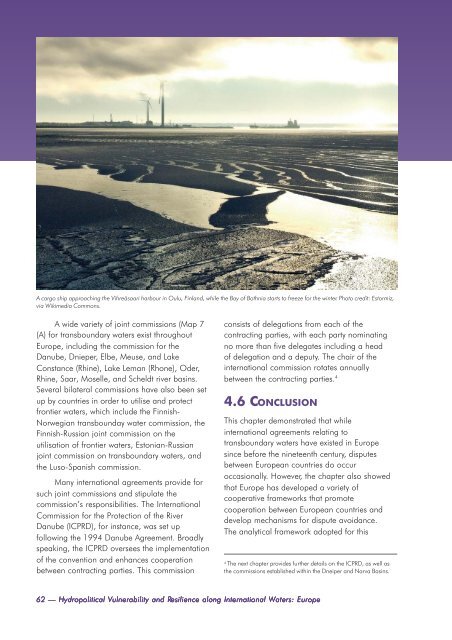Europe - UNEP
Europe - UNEP
Europe - UNEP
You also want an ePaper? Increase the reach of your titles
YUMPU automatically turns print PDFs into web optimized ePapers that Google loves.
A cargo ship approaching the Vihreäsaari harbour in Oulu, Finland, while the Bay of Bothnia starts to freeze for the winter. Photo credit: Estormiz,<br />
via Wikimedia Commons.<br />
A wide variety of joint commissions (Map 7<br />
(A) for transboundary waters exist throughout<br />
<strong>Europe</strong>, including the commission for the<br />
Danube, Dnieper, Elbe, Meuse, and Lake<br />
Constance (Rhine), Lake Leman (Rhone), Oder,<br />
Rhine, Saar, Moselle, and Scheldt river basins.<br />
Several bilateral commissions have also been set<br />
up by countries in order to utilise and protect<br />
frontier waters, which include the Finnish-<br />
Norwegian transbounday water commission, the<br />
Finnish-Russian joint commission on the<br />
utilisation of frontier waters, Estonian-Russian<br />
joint commission on transboundary waters, and<br />
the Luso-Spanish commission.<br />
Many international agreements provide for<br />
such joint commissions and stipulate the<br />
commission’s responsibilities. The International<br />
Commission for the Protection of the River<br />
Danube (ICPRD), for instance, was set up<br />
following the 1994 Danube Agreement. Broadly<br />
speaking, the ICPRD oversees the implementation<br />
of the convention and enhances cooperation<br />
between contracting parties. This commission<br />
consists of delegations from each of the<br />
contracting parties, with each party nominating<br />
no more than five delegates including a head<br />
of delegation and a deputy. The chair of the<br />
international commission rotates annually<br />
between the contracting parties. 4<br />
4.6 CONCLUSION<br />
This chapter demonstrated that while<br />
international agreements relating to<br />
transboundary waters have existed in <strong>Europe</strong><br />
since before the nineteenth century, disputes<br />
between <strong>Europe</strong>an countries do occur<br />
occasionally. However, the chapter also showed<br />
that <strong>Europe</strong> has developed a variety of<br />
cooperative frameworks that promote<br />
cooperation between <strong>Europe</strong>an countries and<br />
develop mechanisms for dispute avoidance.<br />
The analytical framework adopted for this<br />
4<br />
The next chapter provides further details on the ICPRD, as well as<br />
the commissions established within the Dneiper and Narva Basins.<br />
62 — Hydropolitical Vulnerability and Resilience along International Waters: <strong>Europe</strong>
















